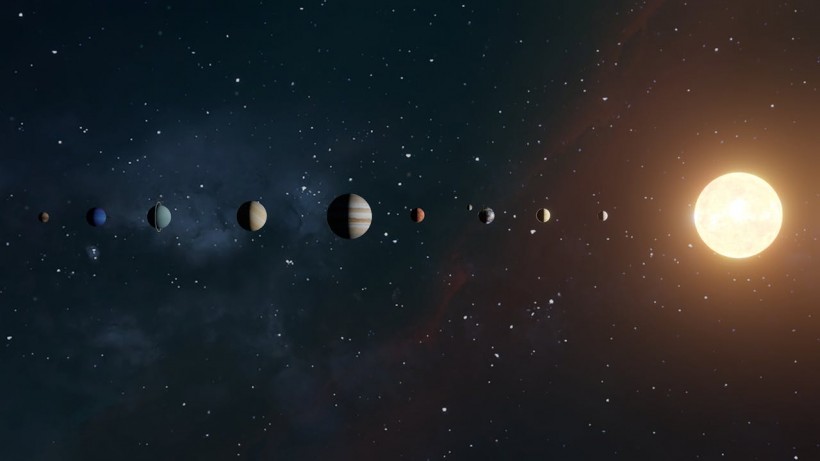The Solar System encompasses a vast expanse featuring eight planets, approximately half a dozen dwarf planets, numerous moons, and millions of asteroids and comets, all orbiting the Sun, sometimes interweaving at speeds comparable to thousands of miles per hour, resembling a colossal spinning top.
Pinpointing the solar system's outer boundary is complex, with three potential candidates identified by NASA: the Kuiper Belt, the Oort Cloud, and the heliopause.

(Photo : Pexels/ZCH)
Kuiper Belt
NASA estimates that the Kuiper Belt extends between 30 and 50 astronomical units (AU) from the sun, with each AU representing the distance from Earth to the sun. This area teems with asteroids and dwarf planets, including Pluto, displaced from the inner solar system due to gravitational interactions with the planets.
Certain astronomers advocate for considering the Kuiper Belt as the solar system's edge, as it roughly delineates the outer limit of the sun's protoplanetary disk, where planets and other celestial bodies formed. However, this perspective is criticized by others, such as Caltech's Mike Brown, who argue that defining the solar system solely based on its planetary bodies oversimplifies its complexity.
The dynamic nature of celestial bodies' movements, particularly outward, since the solar system's formation challenges the notion that the Kuiper Belt encapsulates all solar system components. This includes the potential existence of Planet Nine, theorized to lie beyond the Kuiper Belt.
Recent discoveries of objects beyond the Kuiper Belt have hinted at the possibility of a "second Kuiper Belt," further complicating attempts to establish a definitive boundary for the solar system. Consequently, some researchers contend that relying on the Kuiper Belt as a boundary for the solar system is unreliable.
Oort Cloud
The Oort Cloud, positioned far beyond Pluto and the outer reaches of the Kuiper Belt, is envisioned as a massive spherical shell enveloping the Sun, planets, and Kuiper Belt Objects in a bubble-like formation composed of icy, comet-like bodies, some as substantial as mountains.
NASA estimates the Oort Cloud's expanse to reach approximately 100,000 astronomical units (AU) from the sun, constituting the furthest and most expansive potential boundary of the solar system. For proponents who define the solar system as encompassing all celestial bodies gravitationally bound to the Sun, the Oort Cloud represents a clear demarcation.
However, some researchers contend that the Oort Cloud, situated in interstellar space, lies beyond the solar system despite its gravitational tethering to our star. While the Oort Cloud presents a compelling option for defining the solar system's outer limit, uncertainties regarding its exact boundaries raise questions about its reliability as a definitive border, akin to the uncertainties surrounding the Kuiper Belt's role as a boundary marker.
READ ALSO: What Is Coldest Place in the Solar System? How Does It Compare to the Freezing Temperature on Earth?
Heliopause
The heliopause marks the outer boundary of the sun's magnetic influence, defining the heliosphere. Beyond this point, the solar wind, comprised of charged particles emitted by the sun, weakens, allowing radiation from stars and cosmic entities in the Milky Way to penetrate. Some consider heliopause to be the limit of the solar system due to the transition from solar-origin plasma within to interstellar-origin plasma outside.
Voyager 1 and Voyager 2, spacecraft that journeyed beyond the heliopause in 2012 and 2018 respectively, detected significant changes in magnetism and radiation upon crossing this boundary. Despite its name, the heliosphere is not spherical but rather oblong due to the direction of interstellar plasma bombardment, creating a bow shock around 120 AU from the sun and an extended tail stretching at least 350 AU in the opposite direction.
Using the heliopause as the solar system's boundary results in an asymmetric configuration, contradicting some researchers' views of planetary systems as more evenly distributed entities.
Nonetheless, researchers and NASA often cited the heliopause as the solar system's edge due to its definable nature and distinct magnetic properties. However, beyond the heliopause, objects like 'Oumuamua may still belong to the solar system, leading to debate among researchers regarding the existence of multiple boundaries.
RELATED ARTICLE: Stars, Planets, and Moons: Why Celestial Bodies Are Spherical in Shape?
Check out more news and information on Space in Science Times.














